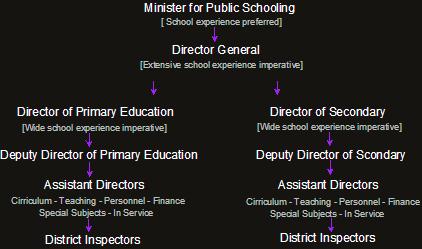
[Each position to have adequate staffing. Special consideration for public service officers who have served as administrative or teacher assistants in schools and known to have deep knowledge of school routines.]
1. Curriculum [i.e. guiding children through learning experiences] This sector makes sure that activities are first rate and are given constant attention. Those at Assistant Director level will link with District Inspectors who are in schools every day, so that feed-back to syllabus [recorded essential elements of the overall curriculum] outlines is constant, critical and constructive.
2. Teaching techniques require regular personal thought. The sharing of good ideas, celebrating successes, examining innovative practices and the like need to receive constant attention. The pursuit of excellence in teaching is the aim. Guarding subject-time allocations and protecting schools from well-meaning lobbies requires constant surveillance.
3. Personnel. Location of staff, linking levels and kinds of staffing with local circumstances, matching departmental requirements with personal desires, staffing of remote and unpopular areas, organising requirements for promotional assessment are very taxing activities for a large state.
4. Finances. There is usually an enormous number of competing demands for limited finances. Compulsory Schooling seldom attracts much fiscal attention, so it important that the budget allocations are pupil based. [9. Four Way Test]
5. Special Subjects. Since syllabuses are constantly changing and improving, some subjects require emphasis from time to time. New movements require supervision and evaluation. This section would also supervise requirements for those pupils with special needs, who need separate schools and buildings and specially trained teachers.
6. In-Service. Constant, well-articulated programs that cover all of the above are needed to keep school learnings lively.
Non-State School Involvement: The Minister is responsible for the attendance and instruction of all children of compulsory school-age. Some of these attend schools run by religious organisations and private entrepreneurs. The Catholic church conducts the largest number of alternative non-state schools and has traditionally worked closely with state authorities in curriculum offerings and the maintenance of teaching competence. Jealous of its overall standards it once sought and welcomed regular inspection and open comment by state school Inspectors and the like. It cared about all children and opened its doors wide.
Other churches and religious organisations have also established schools as have those who believe that they can operate schools that ‘do things better’. Once bona fides have been established, co-operation needs to be recognised, upheld and supported.
The Minister, retaining responsibility for the educational welfare of all of the children and accepting of alternative arrangements, should involve a representative of the non-state sector at the Deputy or Assistant-Director level. This person would not be an employee of the state and a largely liaison format would benefit all concerned. Appointment and an administrative network that such schools deem necessary can be established with little interference to the state network.
Stakeholders: At various levels in the structure, there is need to involve other stake-holders….not just to listen to…to involve. While a list of all concerned would be in the thousands, there are representative groups whose help and advice is required. They include the following…
1. Principal Associations and Associate Administrators must be part of every activity that affects them. Their involvement will be with the Director-General’s triad.
2. Parents and teachers have their professional associations and their unions ….subject associations, year levels groups, multi-age and other teaching-concerned associations.
3. It is essential that tertiary institutions, especially those who prepare student teachers, are involved. They need to know what is going on and what is planned. Some tertiary teachers are respected provocateurs and many conduct particularly useful research; and there are millions of academic treatises describing school activities. The efforts are appreciated.
4. Learned Societies such as the Australian Council for Educational Leadership [ACEL] and the Australian College of Education [ACE] should be invited to participate.
5. Non-state schools will be represented in the structure, but the involvement of representative groups at the operating levels will assist in the sharing and disbursement of information.
A judicious representation of stakeholders is not difficult and need not be as crowded as the above would appear to represent.
Don’t be awed by the simplicity of this design. It would be a brave state that would dare to introduce such a no-nonsense, down-to-earth structure. It will have to overcome that egalitarian fear of excellence and avoid presentations from present day business models and managerial ‘experts’ who tend to structure from the top. Not easy.
Conclusion: A framework such as this will work. The use of experience and first-hand knowledge will produce outstanding results in all facets of schooling. I am sure of it.
There is wide-spread alarm by what is happening at present, especially when present day activities hamper the wonderful work that classroom teachers are capable of doing. They need proper assistance and support.
They need a thoroughly school-based adminsitraion.

